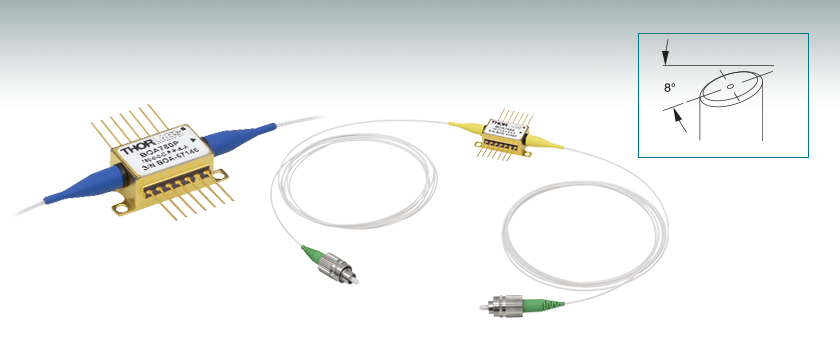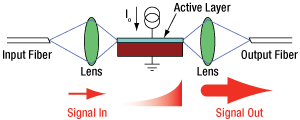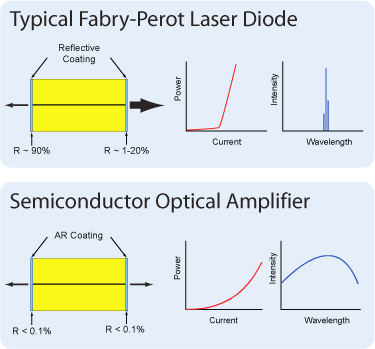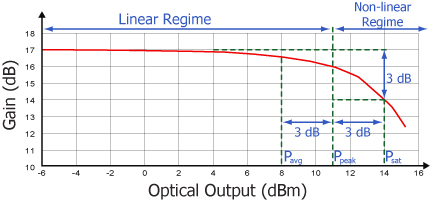Booster Optical Amplifiers (BOAs), 780-795 nm

- Polarization-Dependent Booster Optical Amplifiers (BOAs)
- SM or PM-Fiber-Pigtailed Butterfly Package
- 780, 785, or 795 nm Operational Wavelengths
- Small Signal Gain of 25, 17, or 24.5 dB
FC/APC Connectors
BOA780P
BOA with PM Fiber and
FC/APC Connectors, Close-Up of Butterfly Package Shown
BOA785S
BOA with SM Fiber and
FC/APC Connectors

Please Wait
| Optical Amplifier Selection Guide |
|---|
| 780 - 795 nm BOAs |
| 830 nm BOAs |
| 930 nm BOAs |
| 980 nm BOAs |
| 1050 nm BOAs |
| 1210 nm BOAs |
| 1250 nm BOAs |
| O-Band (1285 - 1350 nm) BOAs |
| E-Band (1410 nm) BOAs |
| C-Band (1550 nm) BOAs and SOAs |
| L-Band (1590 - 1625 nm) BOAs |
| 1685 nm BOAs |
| 1700 nm BOAs |
Applications
- Amplifying Polarized Laser Signals Around 780 nm, 785 nm, or 795 nm
- Amplifying Widely Tunable Lasers Around 780 nm, 785 nm, or 795 nm

Click to Enlarge
When current is applied across the ridge waveguide, excited state electrons are stimulated by input light, leading to photon replication and signal gain.
Features
- Polarization Dependent: Amplifies One Polarization State
- 1.5 m Long, SM or PM Fiber Pigtails with FC/APC Connectors
- Small Signal Gain: 25 dB, 17 dB, or 24.5 dB (Typical)
- Saturation Output Power: 13 dBm, 16.5 dBm, or 13.5 dBm (Typical)
- 3 dB Bandwidth: 18.5 nm, 28 nm, or 20 nm (Typical)
- Each End Face of the Semiconductor is AR Coated (R < 0.1%) to Prevent Lasing
Booster Optical Amplifiers (BOAs) are single-pass, traveling-wave amplifiers that perform well with both monochromatic and multi-wavelength signals. Since BOAs only amplify one state of polarization, they are best suited for applications where the input polarization of the light is known. The BOAs consist of a highly efficient GaAs Quantum Well (QW) layer structure, which is designed for amplifying polarized optical signals around 780 nm, 785 nm, or 795 nm and is also an ideal gain medium for implementing wide-bandwidth tunable lasers.
As seen in the schematic to the right, the input and output of the amplifier are coupled to the active layer of the ridge waveguide on the optical amplifier chip. The device is contained in a standard 14-pin butterfly package, with either single mode or polarization-maintaining fiber pigtails that are terminated with 2.0 mm narrow key FC/APC connectors. The BOA780, BOA785S, and BOA795 use single-mode, non-polarization-maintaining 780HP fiber. The BOA780P and BOA795P use polarization-maintaining PM780-HP fiber. An integrated thermoelectric cooler (TEC) and thermistor allow the BOAs to be temperature controlled, thus stabilizing the gain and the spectrum.
For additional details concerning the construction and operating parameters of our BOAs, please see the Optical Amplifiers tab.
Mount and Driver Options
These butterfly packages are compatible with the CLD1015 laser diode mount with integrated controller and TEC. When operating the BOAs on this page with the CLD1015, the orientation for type 1 pin configurations should be used. They are also compatible with the LM14TS and LM14S2 mounts, which can be used with our laser diode, TEC, and combined current/TEC controllers. When operating these lasers in environments with more than 5 °C variation in temperature, we recommend using the LM14TS mount, which provides active control of the butterfly package's case temperature to stabilize the amplifier's output wavelength and power.
ASE Center Wavelength
The center wavelength (CWL) of the amplified spontaneous emission (ASE) spectrum in broadband semiconductor devices, such as optical amplifiers, may show variation between lots. Please refer to the blue icons (![]() ) below for the CWL tolerances of each particular model. For applications in which a specific ASE center wavelength is a critical concern, please contact Tech Sales for information on the CWL of currently available lots.
) below for the CWL tolerances of each particular model. For applications in which a specific ASE center wavelength is a critical concern, please contact Tech Sales for information on the CWL of currently available lots.
| Item #a | Info | Center Wavelengthb |
Max Operating Current | 3 dB Bandwidth |
Saturation Output Power (@ -3 dB)c,d |
Small Signal Gain (@ Pin = -20 dBm)c,d |
Noise Figurec,d | Fiber Type |
|---|---|---|---|---|---|---|---|---|
| BOA780 | 776 nm | 325 mA | 18.5 nm | 13 dBm | 25 dB | 9.8 dB | 780HP | |
| BOA780P | PM780-HP | |||||||
| BOA785S | 775 nm | 325 mA | 28 nm | 16.5 dBm | 17 dB | 9.5 dB | 780HP | |
| BOA795 | 791 nm | 325 mA | 20 nm | 13.5 dBm | 24.5 dB | 9 dB | 780HP | |
| BOA795P | PM780-HP |

Booster optical amplifiers (BOAs) and semiconductor optical amplifiers (SOAs) are single-pass, traveling-wave amplifiers that perform well with both monochromatic and multi-wavelength signals. Since BOAs only amplify one state of polarization, they are best suited for applications where the input polarization of the light is known. For applications where the input polarization is unknown or fluctuates, a Semiconductor Optical Amplifier (SOA) is required. However, the gain, noise, bandwidth, and saturation power specifications of a BOA are superior to that of a SOA because of the design features that make the SOA polarization insensitive.
BOAs and SOAs are similar in design to Fabry-Perot Laser Diodes, the difference being that Fabry-Perot laser diodes have reflective coatings on both end faces of the semiconductor chip. The optical feedback from the reflective end faces establishes a cavity in which lasing can occur. SOAs and BOAs have an anti-reflection (AR) coating on both end faces of the semiconductor chip. The AR coatings limit the optical feedback into the chip so that lasing does not occur.
As is typical for all amplifiers, BOAs/SOAs operate in two regimes: a linear, flat, constant gain regime and a non-linear, saturated output regime. When used to amplify a modulated signal, the linear regime is typically used to eliminate pattern-dependent distortion, multi-channel cross-talk, and transient response issues common to EDFAs. The non-linear regime is used to take advantage of the highly non-linear attributes of the semiconductor gain medium (cross-gain modulation, cross phase modulation) to perform wavelength conversion, optical 3R regeneration, header recognition, and other high-speed optical signal processing functions.
For a continuous wave input signal, the amount of power that can be produced by the amplifier is determined by the saturation output power (Psat) parameter. Psat is defined as the output power at which the small-signal gain has been compressed by 3 dB. The maximum amount of CW power that can be extracted is approximately 3 dB higher than the saturation power.

| Posted Comments: | |
Menachem Polak
(posted 2024-04-01 22:17:32.53) Hi,
In my scenario, my seed laser is pulsed laser with:
wavelength = 785 [nm]
pulse width = 300 [psec]
pulse rep rate = 20 [MHz]
avg power = 0.5 mWatts
so my questions are:
1.will the laser's electro-optic BW handle the pulse and output amplified 300 [psec] pulses with average power of
20 [mWatts]?
2. will the amplifier impact the original seed linewidth (except for the ASE & NF specs mentioned)
Thanks jpolaris
(posted 2024-05-02 07:47:24.0) Thank you for contacting Thorlabs. Given your laser's specifications of 0.5 mW average power, 300 ps pulse width, and a 20 MHz repetition rate, this equates to a peak input power of 78.29 mW. BOA785S would begin to exhibit pulse distortion with an input power of ~10 mW. For this reason, we would not recommend BOA785S in this case. Furthermore, if your requirement is 20 mW average power on the output, this would produce a peak output power of 3.13 W given your laser's specs. This is far above what BOA785S would be able to handle. As for the impact on seed linewidth, at this moment we do not have data on the impact of the BOA on the linewidth of the original laser. However, in principle, laser linewidth should stay the same as long as there is an isolator between the laser and the amplifier such that the noise from the amplifier will not enter the laser. Otherwise, this noise would perturb the laser oscillation. Alok Singh
(posted 2023-11-16 16:43:41.013) Hi,
what is the minimum input power, Is it -20dBm or we can go down to say -40dBm and what will be the amplification at -40dBm? cdolbashian
(posted 2023-11-17 12:59:03.0) Thank you for reaching out to us with this inquiry. There is technically no minimum power, but since the gain is on the order of ~20dB, you might notice that if you start with a small enough signal that the ASE spectrum dominates the output signal. You might have to use optical filters to remove parts of the ASE spectrum in order to see your original wavelength, which has been amplified. Martin Henriksen
(posted 2023-03-16 12:52:23.12) Hi Thorlabs
Is it possible to get the BOA785S in a polarization maintaining version?
Kind regards
Martin
NKT Photonics jdelia
(posted 2023-03-16 01:12:46.0) Thank you for contacting Thorlabs. I have reached out to you directly to discuss the feasibility of this custom request. For future custom requests, you can reach out to us at techsupport@thorlabs.com. Dong IL Lee
(posted 2022-12-19 20:34:17.323) *Revised;
Hi, does this BOA785S can be operated with the LD/TEC controller of ITC4001 or ITC502 along with the LM14S2? Dong IL Lee
(posted 2022-12-19 20:24:27.69) Hi, does this BOA785S can be operated with the LD/TEC controller of ITC4001 or ITC502? ksosnowski
(posted 2022-12-21 11:13:49.0) Thanks for reaching out to Thorlabs. BOA785S can be operated with both of these controllers, ITC502 however would limit the drive current to 200mA. ITC4001 can supply 1A, which is sufficient for BOA785S which has a maximum operating current of 325mA. Sylvain DE LESELEUC
(posted 2022-02-18 18:26:44.97) Hi,
Would it possible to have the BOA785 with PM fiber?
Cheers, Sylvain ksosnowski
(posted 2022-02-18 01:55:15.0) Thanks for contacting us Sylvain, we may be able to offer this BOA with PM fiber as a special item. I am reaching out to discuss your application further. Dong IL Lee
(posted 2022-01-23 21:36:16.693) Dear Thorlabs company,
I have a few questions and have listed them below,
1. Does the BOA support bi-directional amplifying? I am trying to use it bi-directionally(ex. Left -> Right, Right -> Left at the same time). Is it possible to use it like that? If yes, would the amplified power follow the description in the spec sheet? (ex. the saturation output power of 16.5 dBm)
2. Does the polarization controller must be required to use BOA?
Thanks for the consideration
Dong IL Lee YLohia
(posted 2022-01-24 03:25:20.0) Thank you for contacting Thorlabs. Unfortunately, this BOA is not bi-directional. The input and output side of BOA chip design is different to ensure reliable higher power operation on the output side (using a tapered waveguide design). We don’t characterize the performance in the other direction. In general, you will see lower saturation power, lower gain, and higher noise figure when you use the BOA in the other direction. A polarization paddle controller is recommended for this particular BOA since the input fiber is SM (which has an affect on the input polarization state) and the BOA is a polarization-sensitive device. Not using a polarization controller on the input would yield an unstable output and a time-varying gain. |
 Products Home
Products Home










 780 - 795 nm Optical Amplifiers
780 - 795 nm Optical Amplifiers